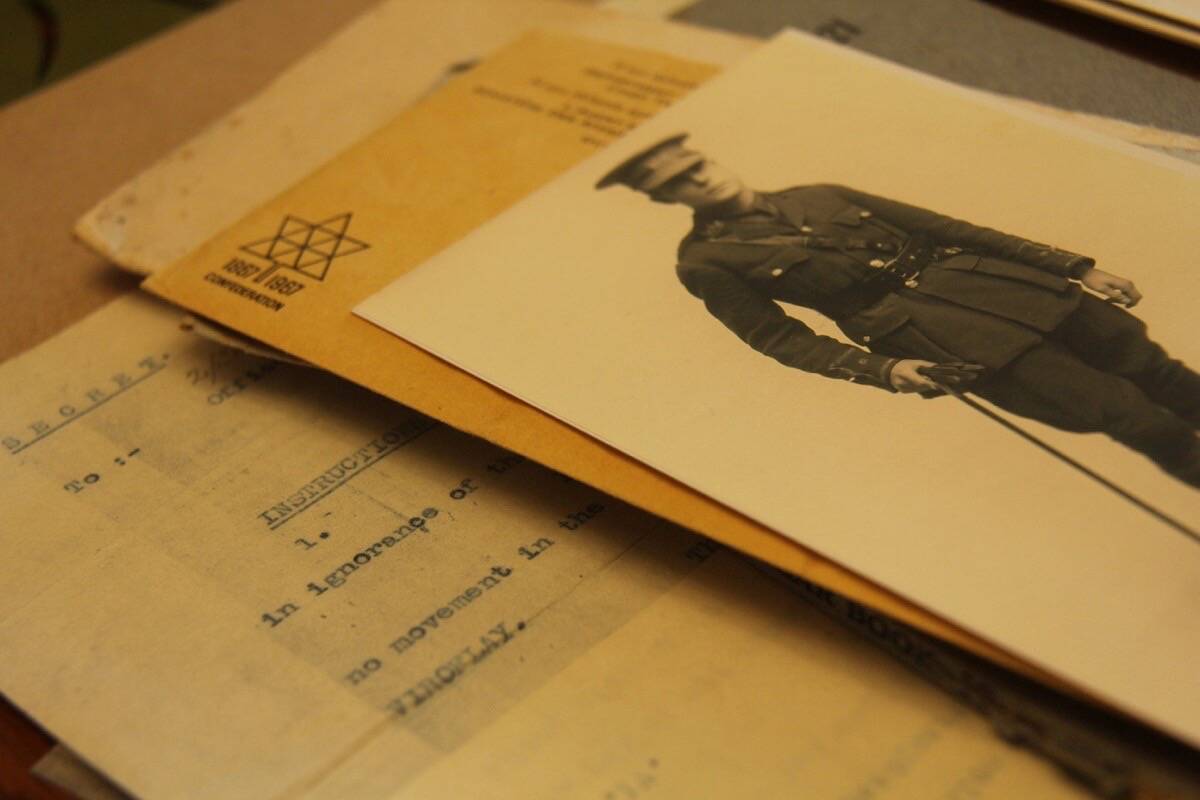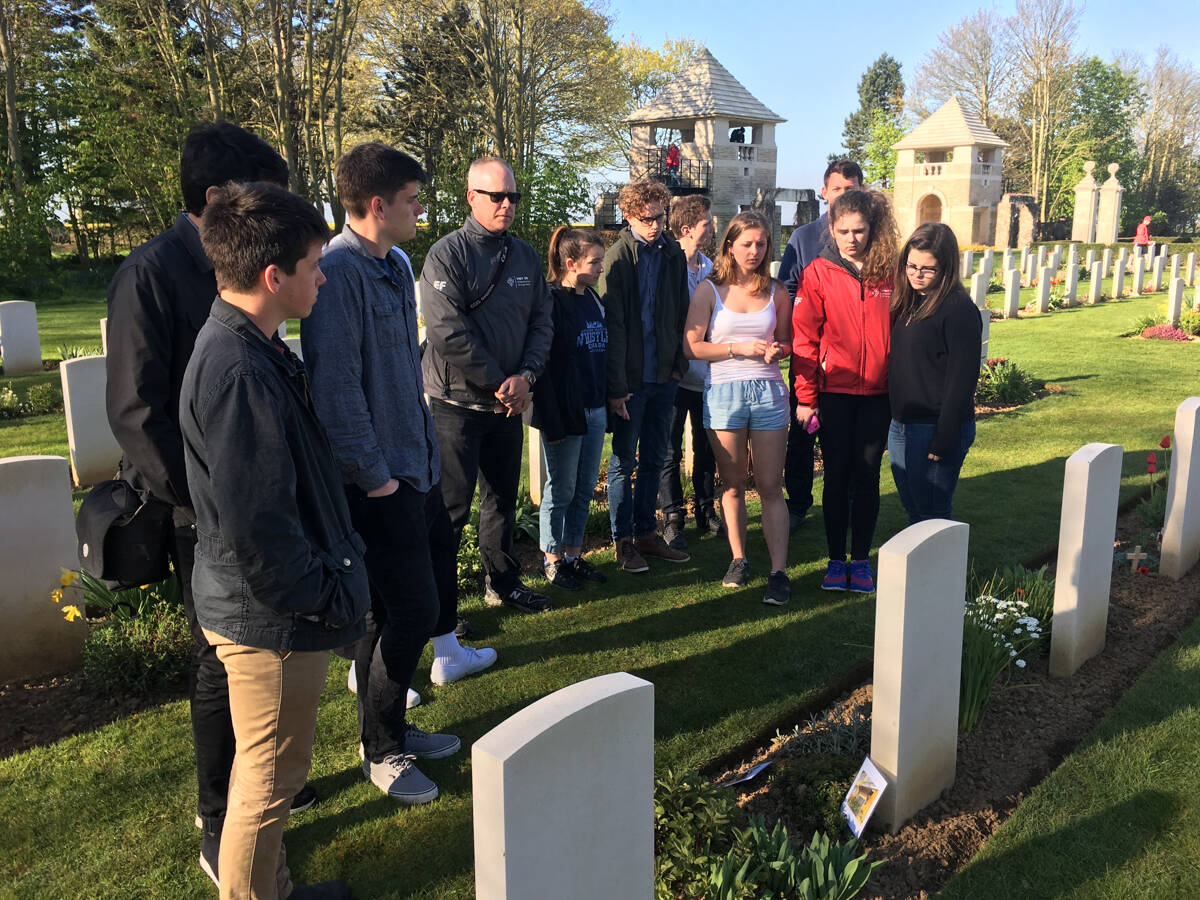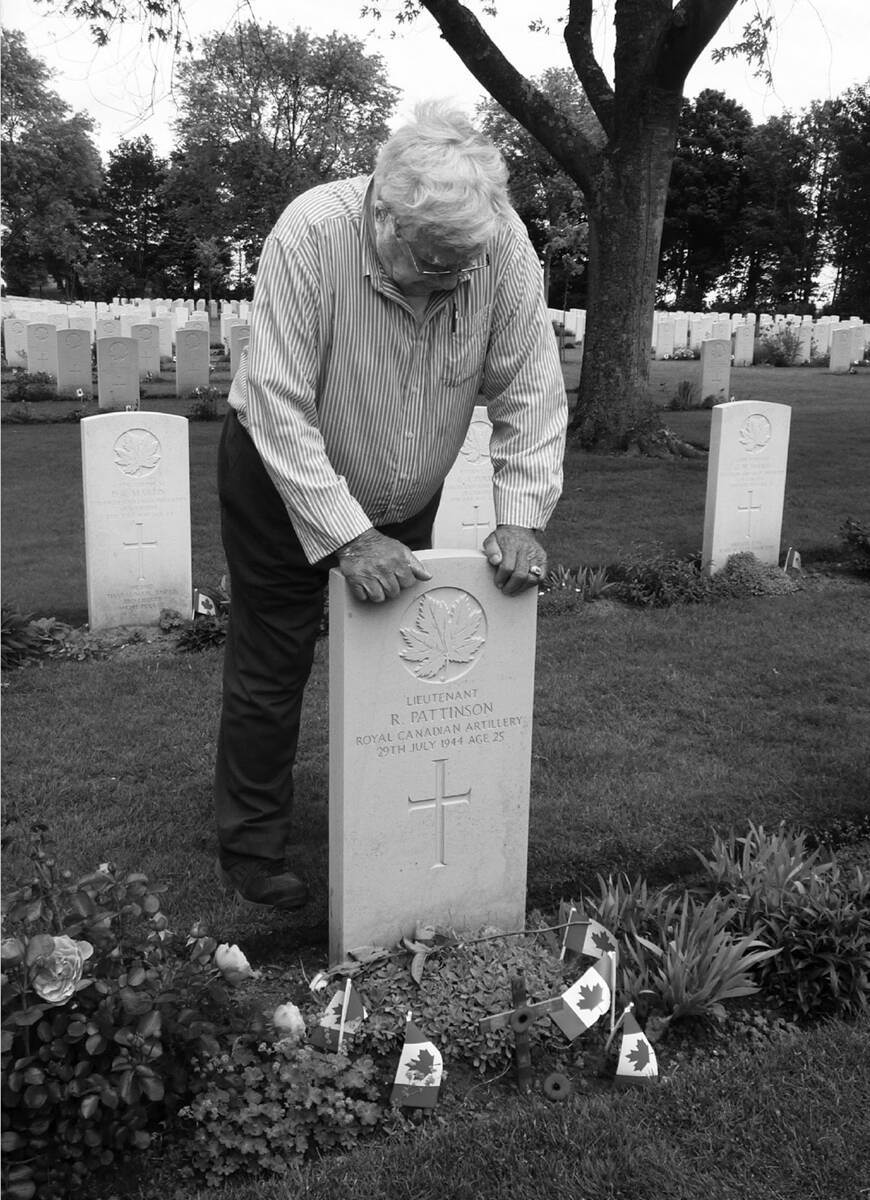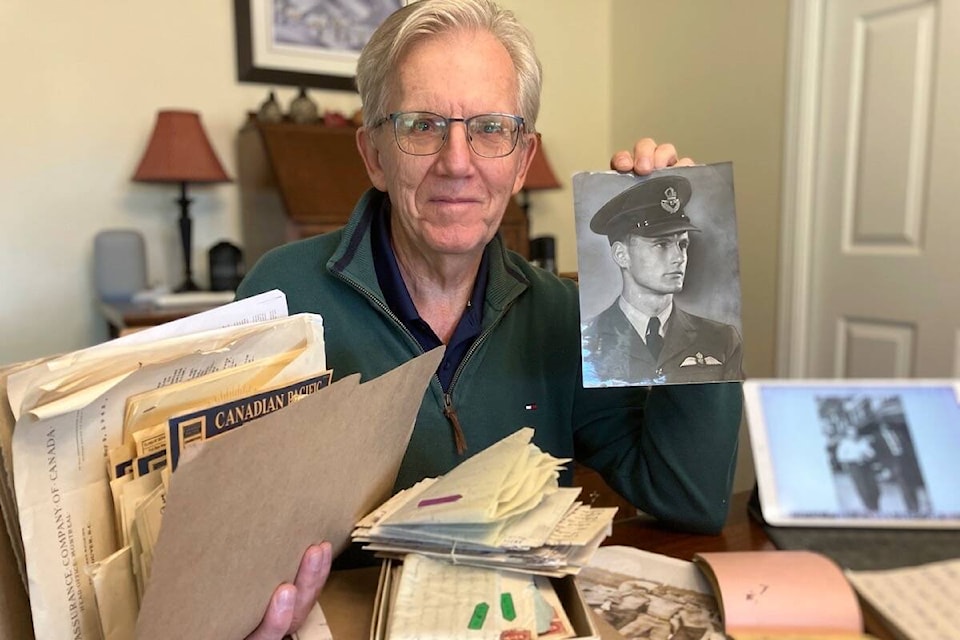Six Oak Bay boys went to war and never came home.
It’s a family story Peter Bradford Palin – who goes by Brad – grew up with. His uncle Peter James Arnold Huke Palin was one of those young men.
“My father told me that his older brother, Peter, and five of his friends all signed up for the war, and that none of them came home,” Brad said.
So Brad was stunned when he found himself seated on a rented bed in a country far from his Central Saanich home staring at a picture he’d never seen before of “five boys horsing around on the beach” with his uncle Peter on the left.

The moment gives him goosebumps just remembering it.
The path to the photo is long in both time and detail and includes an award-winning Oak Bay News article by late journalist Keri Coles smack in the middle. The latest chapter in the seemingly never-ending tale includes a search for the identities of the remaining boys in the photo and enabling education for future youth.
Brad Palin has become the family historian. Upon his dad’s death he inherited the vast amounts of documents from his grandfather and uncle Peter’s military service.
His grandfather Alfred Hugh Palin, who went by Hugh, was a veteran of the First World War – wounded in the trenches in France and spent his remaining wartime in a prison camp before being invalided back to England.
He’d come to Canada before the war, in 1912, and homesteaded with his brothers in remote Manitoba before working in a Saskatchewan bank then enrolled for war and was sent to France. He was wounded at the battle of Villers-Bretonneaux and Brad still has his notes from the night Hugh was captured.
“How this stuff has survived I have no idea,” he said, gesturing to a note from commanders warning “We expect the Germans to attack at 2 a.m. and these are your orders” and Hugh’s subsequent note to those under his command.
“Somehow held onto all that stuff as a prisoner in a German camp,” Brad said.

Peter’s death seemed a final blow for Hugh though. He’d survive the war and the loss of two wives. The Palins lived on Hampshire Road in Oak Bay from 1925 to about 1945 before moving to Mount Doug Cross Road where Hugh became a “gentleman farmer.”
Brad’s path to the photo of five boys on the beach starts on a European vacation with his wife Janet and eldest son Grant.
The second leg of the trip included visits to French sites steeped in Second World War history, such as Juno Beach – visiting the museum and other battle sites in the area with local guide Romain Breget.
“It was amazing, he had a binder full of maps and diagrams and before and after pictures … they just brought the whole horrific scene to light for us. It was really an amazing day.”
Brad remembers so clearly the mid-afternoon visit to a Canadian cemetery and the one particular grave site on the meticulously maintained grounds. Breget told stories while walking through the masses of headstones with birth and death dates that highlighted the youth of those taken by war.
Breget knew the Palins were from Victoria and led them to a particular grave – that of former Oak Bay resident Lt. Roy Pattinson.
In 1937, at 18, he joined the army. After years of training in Victoria, Halifax, and England, Pattinson went into battle with the Royal Canadian Artillery, landing on Juno Beach 12 days after the Allies launched Operation Overlord (commonly called D-Day) in Normandy on June 6, 1944. He was killed July 29 of that year while fighting on the outskirts of Caen.
Breget had many more details though. He told them how Roy’s father was a pharmacist and had a pharmacy on Oak Bay Avenue which used to be the family home, and is now the Penny Farthing. He told them of Oak Bay High students who visited in 2017 and how it led to a veteran who served with Pattinson connecting with Roy’s descendants.
“I thought, ‘How can he know this stuff?’” Brad said. “I just thought this was amazing. It gave me chills that we were able to get that kind of random detail from a grave.”
It dawned on him that Roy was born in 1919. While Brad’s dad was born much later in 1931, his older brother Peter was also born in 1919.
“Dad grew up on Hampshire Road around the corner a couple houses from Bowker Creek,” Brad said. Peter also attended Willows Elementary and Oak Bay High. He figured they had to know each other.
“I couldn’t believe the coincidence of being halfway around the world and finding a link to my family at a cemetery of 2,000-plus graves,” Brad said.
Peter was killed in 1942 when a propeller came loose and his plane crashed in an English field.
“He never even made it to war in France, he was killed on a training flight in England,” Brad said. Consequently, he didn’t expect to learn much of his uncle while travelling in France. “It was just mind-blowing to me.”
That night sitting in his French accommodation he was inspired to get online and look for more information.
He found a 2017 Oak Bay News story outlining the information the tour guide had shared.
VIDEO: 92-year-old WWII veteran united with family of fallen soldier after decades-long search
“That story, complete with pictures popped up, including a picture of Roy and friends on a beach. Right next to him is my uncle Peter,” Brad said. “I couldn’t believe the coincidence of being halfway around the world and finding a link to my family at a cemetery of 2,000-plus graves.”
He’s become the default family historian and returned to his Central Saanich home to peruse his files on Peter – complete with loads of pictures of him at varying stages of his short military career.
“I found all the condolence cards my grandfather received when Peter was killed in 1942. Going through them I found a little envelope from the Oak Bay florist shop … it was from the Pattinson family,” Brad said. “I found Peter’s autograph book and flipped through it reading all the names.”
Many were familiar Oak Bay names, including Roy Pattinson.
“This just brought it all home to me that they were really close friends,” he said.
Brad booked some time at the Oak Bay Archives where he perused the Pattinson family album and spotted Uncle Peter, Aunty Pat, Aunty Dorita (called Peggy in the album) and even his dad Hugh among the black-and-white images – offering identity to previously nameless faces.
Including the five boys on the beach. With two now positively identified, and a strong likelihood Ray Walls is the lad on the right. All three are named on the Oak Bay cenotaph on Beach Drive.
The search continues for the names of the other boys.
Brad feels the group of Oak Bay High students was critical to the revelations. Without that story he wouldn’t have made the connection.

In April 2017 to commemorate the 100th anniversary of the Battle of Vimy Ridge, Oak Bay High teacher Scott Alexander and vice-principal at the time Jason Johnson, recruited 11 students to go on a trip to France. They were among 8,000 kids from Canada who attended a ceremony at Vimy Ridge as part of an Education First tour.
Alexander remembers his approach to making it meaningful, tangible for the young people in his charge. “How do we do meaningful activities with kids that resonate personally?” is always a focus.
He located two former Oak Bay High students killed in war and buried near where the group would visit. Pattinson’s grave was one of them. Even just having that information was serendipitous to Alexander.
“I wouldn’t have had that information had not a retired teacher put together this package of every student who fought in the war from Victoria high schools.”
In what seemed a small gesture, he had students create cards of thanks, and with a moment of silence, left them on the graves.
They stood at the grave and read out the information they knew, had a moment of silence and then the kids placed their cards.
“Then the personal became this long spider web of attachment,” Alexander said. “That to me is a real thing of just trying to honour the dead in some way that is recognizing humanity. Sometimes we’re struck with all this loss.”
With a picture and information about Oak Bay High, the cards led the French tour guide to learn of the Oak Bay News story.
The piece, which subsequently earned Coles a national award, told the tale of how a then 92-year-old Second World War veteran from Ottawa struggled to find someone he sought for decades.

Roly Armitage was there the day Roy Pattinson was killed. For years he’d been looking for family of the command post officer he had befriended while working as his technical assistant in an artillery regiment during training in England and on the battlefield in France. With only a name, his search always came up empty, until he saw the Oak Bay High cards on the grave site.
A couple of phone calls later and he was in touch with the Oak Bay Archives where the archivist shared his contact information with Louise Barber, Pattinson’s niece by way of adoption.
It was a connection both had been seeking and it left an impact.
Coming full circle all these years later, Barber and Alexander are in touch again, as the woman looks to leave a legacy for her family – funding a scholarship for an Oak Bay High student pursuing pharmacology or something similar.
With war still a reality worldwide, the ongoing impacts of this never-ending story highlight the lasting impact of something as simple as being engaged with your eyes wide open can have, Alexander said.
“The magic is just that it helps to keep history alive. And to see that families are long impacted by the sacrifice of war.”
